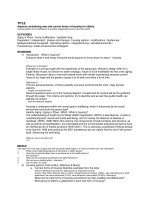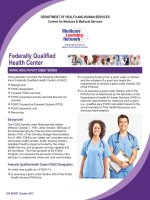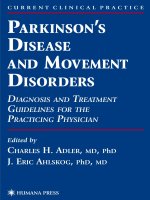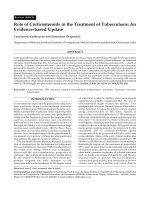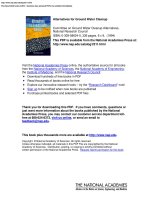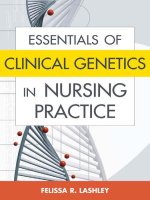Justification of Estimates for Appropriations Committees 2012 potx
Bạn đang xem bản rút gọn của tài liệu. Xem và tải ngay bản đầy đủ của tài liệu tại đây (1.97 MB, 431 trang )
DEPARTMENT
of HEALTH
and HUMAN
SERVICES
Fiscal Year
2012
Health Resources and
Services Administration
Justification of
Estimates for
Appropriations Committees
MESSAGE FROM THE ADMINISTRATOR
I am pleased to present the FY 2012 Congressional Justification for the Health Resources and
Services Administration (HRSA). This budget targets critical healthcare needs in underserved
areas.
It is estimated that in FY 2012 approximately 24.4 million patients will receive access to high
quality, comprehensive and cost-effective primary health care through HRSA’s Health Center
program. Additional resources are also provided for the Ryan White HIV/AIDS program to
enhance prevention and treatment of people impacted by HIV/AIDS. Through the AIDS Drug
Assistance Program, requested resources will provide life saving medications to 218,446 people
infected with HIV. In July, 2010, the Obama Administration released the National HIV/AIDS
Strategy (NHAS) and Implementation Plan for the United States. HRSA has an essential role to
play in meeting the NHAS goals and is working across its Bureaus to fulfill the implementation
plan activities. The budget also requests funding for other programs that play a key role in
driving down costs and expanding healthcare access for the whole family.
The FY 2012 budget invests resources to increase the number of doctors, nurses and dentists in
areas of the country experiencing shortages of health professionals. This will ensure that
qualified clinicians will be available to serve underserved populations in the future. The budget
also includes $124 million to improve both access to and quality of health care in rural areas.
This will strengthen regional and local partnerships among rural health care providers, expand
community-based programs and promote the modernization of the health care infrastructure in
rural areas.
This budget request supports achievement of the Agency’s four strategic goals, which are to:
• Improve Access to Quality Health Care and Services
• Strengthen the Health Workforce
• Build Healthy Communities
• Improve Health Equity
Our FY 2012 budget request places a strong emphasis on investing in programs that improve
access to health care in underserved areas and allows the Health Resources and Services
Administration to take important steps toward achieving health care reform.
Mary K. Wakefield
Administrator
TABLE OF CONTENTS
FY 2012 Budget
Organization Chart 1
Executive Summary 2
Introduction and Mission 3
Overview of Budget Request 4
Overview of Performance 8
Summary of Performance Targets and Results 12
ARRA Performance Overview 13
All Purpose Table 16
Health Resources and Services
Budget Exhibit
Appropriation Language 21
Language Analysis 25
Amounts Available for Obligation 29
Summary of Changes 31
Budget Authority by Activity 34
Authorizing Legislation 37
Appropriations History Table 47
Narrative by Activity
Primary Health Care 51
Health Centers 51
Community Health Center Fund – Construction 62
School Based Health Centers – Facilities 63
Free Clinics Medical Malpractice 65
National Hansen’s Disease Program 68
National Hansen’s Disease Program - Buildings and Facilities 73
Payment to Hawaii 74
Clinician Recruitment and Services 76
National Health Service Corps 76
Nursing Education Loan Repayment and Scholarship Programs 84
Faculty Loan Repayment Program 88
Health Professions 90
Summary of Request 90
Health Professions Training for Diversity 103
Centers of Excellence 103
Scholarships for Disadvantaged Students 106
Health Careers Opportunity Program 109
Health Care Workforce Assessment 112
Primary Care Training and Enhancement Program 115
Oral Health Training Programs 121
Teaching Health Center Graduate Medical Education Payments 127
Interdisciplinary, Community- Based Linkages 130
Area Health Education Centers (AHEC) Program 130
Geriatric Programs 134
Allied Health and Other Disciplines 141
Mental and Behavioral Health Education and Training 143
Public Health Workforce Development 148
Public Health and Preventive Medicine 148
State Health Care Workforce Development 154
Nursing Workforce Development 157
Advanced Education Nursing 157
Nursing Workforce Diversity 162
Nurse Education, Practice, Quality and Retention Program 166
Nurse Faculty Loan Program 170
Comprehensive Geriatric Education 173
Nurse Managed Health Clinics 176
Patient Navigator Outreach and Chronic Disease Prevention Program 179
Children’s Hospitals Graduate Medical Education Payment Program 182
Teaching Health Centers Development Grants 184
National Practitioner Data Bank 187
Maternal and Child Health 190
Maternal and Child Health Block Grant 190
Autism and Other Developmental Disorders 202
Traumatic Brain Injury 207
Sickle Cell Services Demonstration Program 211
James T. Walsh Universal Newborn Hearing Screening 214
Emergency Medical Services for Children 217
Healthy Start 220
Heritabl
e Disorders Program 227
Congenital Conditions 235
Nutrition, Physical Activity and Screen Time Standards 237
Family-To-Family Health Information Centers 239
Maternal, Infant, and Early Childhood Home
Visiting Program 242
HIV/AIDS 245
Ryan White HIV/AIDS Overview 245
Em
ergency Relief Grants – Part A 255
HIV Care Grants to States – Part B 260
Early Intervention Services – Part C 266
Women, Infants, Children and Youth – Part D 269
AIDS Education and Training Programs – Part F 272
Dental Reimbursem
ent Program – Part F 275
Healthcare Systems 278
Organ Transplantation 278
National Cord Blood Inventory 286
C.W. Bill Young Cell Transplantation Program 290
Poison Control Program 295
Office of Pharmacy Affairs/340B Drug Pricing Program 300
Office of Pharmacy Affairs/340B Drug Pricing Program User Fees 305
State Health Access Program 311
Infrastructure to Expand Access to Care 314
Office of Rural Health Policy 316
Summary of the Request 316
Rural Health Policy Development 322
Rural Healthcare Services Outreach, Network and Quality Improvement Grants 325
Rural Access to Emergency Devices 329
Rural Hospital Flexibility Grants 331
Delta Health Initiative 335
State Offices of Rural Health 337
Denali Commission 340
Radiation Exposure Screening and Education Program 342
Black Lung 345
Telehealth
347
Other Programs
351Program Management
357Family Planning
363Public Health Improvements (Facilities and Other Projects)
365Healthy Weight Collaborative
Supplementary Tables 368
Budget Authority by Object Class 369
Salaries and Expenses 370
Detail of Full Time Equivalents (FTE) 371
Programs Proposed for Elimination 374
Health Professions Loan Programs 376
Drug Budget 377
Significant Items
379
Health Education Assistance Loans 397
Vaccine Injury Compensation Program 419
Countermeasures Injury Compensation Program 425
OFFICEOFTHEADMINISTRATOR
Administrator
MaryK.Wakefield,Ph.D.,R.N.
DeputyAdministrator
MarciaK.Brand,Ph.D.
SeniorAdvisor
TinaCheatham
ChiefPublicHealthOfficer
KyuRhee,M.D.
(RA)
Officeof
Communications
Director
MartinKramer
(
RA6
)
BureauofPrimary
HealthCare
AssociateAdministrator
JamesMacrae
(RC)
MaternalandChild
HealthBureau
AssociateAdministrator
PetervanDyck
(RM)
BureauofHealth
Professions
AssociateAdministrator
JanetHeinrich
(RP)
OfficeofRuralHealth
Policy
AssociateAdministrator
TomMorris
(RH)
HealthcareSystems
Bureau
Associate
Administrator
JoyceSomsak
(RR)
HIV/AIDS
Bureau
Associate
Administrator
DeborahParhamHopson
(RV)
BureauofClinician
Recruitmentand
Service
AssociateAdministrator
RebeccaSpitzgo
(RU)
Officeof
Legislation
Director
LeslieAtkinson
(RAE)
Officeof
Operations
ChiefOperatingOfficer
ThomasMorford
(RB)
OfficeofFederal
Assistance
Management
Associate
Administrator
MikeNelson(Acting)
(RJ)
OfficeofSpecial
HealthAffairs
Director
TerryAdirim
(RA1)
OfficeofRegional
Operations
AssociateAdministrator
DennisMalcomson
(Acting)
(RE)
OfficeofEqual
Opportunity,Civil
Rights,and
Diversity
Management
Director
M.JuneHorner
(RA2)
OfficeofPlanning
Analysisand
Evaluation
Director
RebeccaSlifkin
(RA5)
DEPARTMENT OF HEALTH AND HUMAN SERVICES
Health Resources and Services Administration
ORGANIZATIONAL CHART
1
2
Executive Summary
TAB
INTRODUCTION AND MISSION
The Health Resources and Services Administration (HRSA), an Agency of the U.S. Department
of Health and Human Services (DHHS), is the principal Federal Agency charged with increasing
access to basic health care for those who are medically underserved. Health care in the United
States is among the finest in the world but it is not accessible to everyone. Millions of families
still face barriers to quality health care because of their income, lack of insurance, geographic
isolation, or language and cultural barriers. The Patient Protection and Affordable Care Act
provides for a substantial expansion of components of the HRSA-supported safety net, including
the Health Centers program, the National Health Service Corps, and a variety of health
workforce development programs, to address these and other access problems.
Assuring a safety net for individuals and families who live outside the economic and medical
mainstream remains a key HRSA role. A recent New England Journal of Medicine article
1
concluded that the existing safety net is simply inadequate and is continuing to deteriorate. It
further noted that, while implementation of health reforms and other factors will affect the
structure, function, and mission of the safety net, the underlying problems that created the need
for a safety net in the first place will not be solved in the near future.
HRSA’s mission as articulated in its Strategic Plan for 2010-2015 is: To improve health and
achieve health equity through access to quality services, a skilled health workforce and
innovative programs. HRSA supports programs and services that target, for example:
• The 50 million Americans who lack health insurance many of whom are racial and
ethnic minorities,
• Over 50 million underserved Americans who live in rural and poor urban neighborhoods
where health care providers and services are scarce,
• African American infants who still are 2.4 times as likely as white infants to die before
their first birthday,
• The more than 1 million people living with HIV/AIDS, both in and out of care,
• The more than 100,000 Americans who are waiting for an organ transplant.
Focusing on these and other vulnerable, underserved groups, HRSA’s leadership and programs
promote the improvements in access, quality and equity that are essential for a healthy nation.
1
America’s Safety Net and Health Care Reform – What Lies Ahead? Irwin Redlener, M.D., and Roy Grant, M.A.,
Posted by New England Journal of Medicine, December 2, 2009.
3
OVERVIEW OF BUDGET REQUEST
The FY 2012 President’s program level request of $9,034,701,000 for the Health Resources and
Services Administration (HRSA) is an increase of $977,544,000 from the FY 2010 Actual level.
Program Increases:
Health Centers (+$1,132.669 million)
This request will continue to support more than 1,100 health center grantees that provide
comprehensive, culturally competent, quality primary healthcare services through more than
8,000 service delivery sites. This request reflects the projected increase in FTCA program
demand, given the recent expansion of the Health Center Program and the significant
projected Health Center Program expansion supported by the Affordable Care Act. This
funding level also includes $1.2 billion appropriated under the Affordable Care Act for health
center service. As a result of the Affordable Care Act funding, the total number of patients
served in FY 2012 is projected to reflect an increase of approximately 900,000.
National Health Service Corps (NHSC) (+$277.057 million)
This request includes $295 million in mandatory funding from the Affordable Care Act. This
budget will support a Field Strength of 10,683. This will fund 389 scholars and 2,971 loan
repayers.
Health Workforce Programs (+$71.294 million) This request includes $255 million in PHS
Evaluation Funds for certain health workforce activities, $15 million from the Prevention and
Public Health Fund.
National Practitioner Data Bank User Fees (+$4.508)
This reflects the estimated User Fees for the National Practitioner Data Bank.
Autism and other Developmental Disorders (+$7.102 million)
$2.6 million of the increase will support LEND interdisciplinary training programs; $2.1
million of the increase will support additional autism intervention research projects
examining areas of particular interest to families as outlined in the Interagency Autism
Coordinating Committee’s 2010 Strategic Plan for Autism Spectrum Disorder Research; and
the remainder will support State demonstration grants, resource centers, a national
evaluation, and a quality improvement initiative.
Maternal, Infant and Early Childhood Visiting Program (+$250.0 million)
This level of funding will provide: $329 million for awards to 56 State grantees and
associated program technical assistance; $10.5 million for 18 awards representing American
Indian tribes, and $10.5 million for research, evaluation, and corrective action technical
assistance for States not meeting benchmarks.
4
HIV/AIDS Early Intervention Part A (+$1.000 million)
The FY 2012 Request will support program activities and services for PLWH in the 24
Eligible Metropolitan Areas, 28 Transition Grant Areas, and 4 states.
HIV/AIDS Early Intervention Part B (+$82.000 million)
The increase will support program activities and includes the provision life-saving
medications to persons living with HIV. The number of clients served by ADAPs is
predicted to be 218,446.
HIV/AIDS Early Intervention Part C (+$5.139 million)
The increase will support the provision of comprehensive primary health care in an
outpatient setting for people living with HIV disease for an additional 6,467 clients. The
FY 2012 Budget Request target for the number of people receiving primary care services
under Early Intervention Services programs is 247,133.
HIV/AIDS Part D (+$.166 million)
This funding level will support primary healthcare and social support services available to
90,000 women, men, transgendered persons, infants, children, youth and adults living with
HIV and AIDS and their affected families at programs in 37 States, D.C., Puerto Rico and
Virgin Islands. The target for the number of female clients provided comprehensive services
through Part D, including appropriate services before or during pregnancy to reduce perinatal
transmission is 57,773.
HIV/AIDS Education and Training Centers Part F (+.074 million)
This funding will help meet the program’s performance goal to, “Maintain the proportion of
racial/ethnic minority healthcare providers participating in the AETC intervention programs”.
HIV/AIDS Dental Services Part F (+.029 million)
These funds will continue to support the reimbursement of applicant institutions, outreach to
people with HIV/AIDS who need dental care, and continued efforts to improve service
coordination among reimbursement recipients and other community-based health service
providers. The FY 2012 Budget Request target for the number of persons for whom a portion
of their unreimbursed oral health costs will be reimbursed is 35,474.
Cord Blood Stem Cell Bank (+$1.926 million)
This funding will support progress toward the statutory goal of building a genetically diverse
inventory of at least 150,000 new units of high-quality cord blood for transplantation and
will, therefore, increase the number of patients in all population groups who are able to
obtain life-saving transplants.
C.W. Bill Young Cell Transplantation Program (+$3.077 million)
This funding will support progress toward the Program’s ambitious performance target of
2,660,000 adult volunteers from racially/ethnically diverse minority population groups listed
on the registry by September 30, 2012. These funds will also be used to support the four
major Program.
5
340b Drug Pricing Program/Office of Pharmacy Affairs (+$3.000 million)
This funding will help to support verification of all HRSA-funded entities, ensuring accuracy
and integrity of the 340B database over time.
340b Drug Pricing Program/Office of Pharmacy Affairs User Fees (+$5.000 million)
This reflects the estimates amount of user fees.
Rural Health Outreach Grants (+$1.361 million)
In FY 2012, the program will support approximately 100 outreach services grants, 12 Delta
grants, 80 network development grants (which include 20 grants for the Workforce Network
Development pilot program and 40 HIT grants), 59 quality improvement grants and 15
network planning grants.
State Office of Rural Health (+$.070 million)
This funding will continue to support key activities for the State Office of Rural Health
Program and will support a grant award to each of the 50 states.
Program Management (+$23.756 million)
This increase supports increased rent associated with the Parklawn building.
Family Planning (+$10.524 million)
The FY 2012 request is expected to support family planning services for approximately
5,247,000 persons, with at least 90 percent of clients having incomes at or below 200 percent
of the federal poverty level. These services include the provision of family planning methods,
education, counseling and related preventive health services.
Decreases:
Patient Navigator (-$4.965 million)
There is no FY 2012 request for this program.
Children’s Hospital GME (-$316.824 million)
There is no FY 2012 request for this program.
Maternal and Child Health Block Grant (-$6.221 million)
This level of funding will provide: $567.9 million for State Block Grant awards; $74.7
million for the SPRANS set-aside, and $11.8 million for the CISS set-aside. The request
eliminates the following: $4.9 million for Oral Health, $3.8 million for Sickle Cell, $3.7
million for Epilepsy, $0.49 million for Fetal Alcohol Syndrome, $5 million for First Time
Motherhood, and $1.5 million for Doula.
Nutrition, Physical Activity, and Screening Standards (-$.255 million)
This program was funded from the Prevention and Public Health Fund in FY 2010.
State Health Access Grants (-$74.480 million)
There is no FY 2012 request for this program.
6
Infrastructure to expand Access to Care (-$100.000 million)
There is no FY 2012 request for this program.
Rural and Community Access to Emergency Devices (-$2.521 million)
There is no FY 2012 request for this program.
Rural Hospital Flexibility (-$14.715 million)
This funding will continue to support a range of activities focusing on CAHs. The program
will award 45 grants in FY 2012. This request will also continue essential support for the
three grantees funded through the Rural Veterans Health Access Program.
Delta Health (-$34.927million)
There is no FY 2012 request for this program.
Denali Project (-$10.0 million)
There is no FY 2012 request for this program.
Public Health Improvements Projects (-$337.300 million)
There is no FY 2012 request for this program.
Investments in Information Technology (IT):
Funding for many of the HRSA Programs includes IT funding for the continued development,
operations and maintenance of the HRSA Electronic Handbooks (EHBs). The EHBs is an IT
Investment that supports the strategic and performance outcomes of the HRSA Programs and
contributes to their success by providing a mechanism for sharing data and conducting business
in a more efficient manner. The EHBs supports HRSA with program administration, grants
administration and monitoring, management reporting, and performance measurement and
analysis.
7
OVERVIEW OF PERFORMANCE
This Performance Budget documents the progress HRSA has made and expects to make in
meeting the needs of uninsured and medically underserved individuals, special needs
populations, and many other Americans. HRSA and its partners work to achieve the vision of
“Healthy Communities, Healthy People.” In pursuing that vision, HRSA’s strategic goals are to:
improve access to quality health care and services, strengthen the health workforce, build healthy
communities, and improve health equity. The performance and expectations for HRSA programs
are highlighted below as these relate to HRSA goals and HHS strategic objectives, indicating the
close alignment of specific programmatic activities and performance with broader HRSA and
Departmental priorities. Many of the highlighted activities also relate to the Secretary’s
Initiative on Transforming Health Care to help all Americans live healthier, more prosperous,
and more productive lives. The examples illustrate ways HRSA helps states, communities and
organizations provide essential health care and related services to meet critical needs.
Highlights of Performance Results and Targets
HRSA Goals: Improve access to quality health care and services; Improve health equity
HHS Objectives: Ensure access to quality, culturally competent care for vulnerable populations;
Emphasize primary and preventive care linked with community prevention services.
HRSA programs support the direct delivery of health services and health system improvements
that increase access to health care and help reduce health disparities.
< In FY 2012, the Health Centers program projects that it will serve 24.4 million patients. This
is an increase of 5.6 million over the 18.8 million persons served in FY 2009.
< Through the Health Centers program, HRSA expects to provide access to care to more than 9
million uninsured individuals in FY 2012. In 2009, 7 million uninsured individuals (38% of
total patients) were served by Health Centers.
< HRSA expects to serve 33 million children through the Maternal and Child Health Block
Grant (Title V) in FY 2012, similar to the number served in FY 2009 (33.3 million).
< By reaching out to low-income parents to enroll their children in the Children’s Health
Insurance Program (CHIP) and Medicaid, HRSA improves access to critically important
health care. In FY 2012, the number of children receiving Title V services that are enrolled
in and have Medicaid and CHIP coverage is expected to reach 14 million. In FY 2009, the
number was 15.2 million.
8
< In FY 2012, HRSA’s Ryan White HIV Emergency Relief Grants (Part A) and HIV Care
Grants to States (Part B) are projected to support, respectively, 2.63 million visits and 2.19
million visits for health-related care (primary medical, dental, mental health, substance
abuse, rehabilitative, and home health). Approximately 2.59 million visits and 2.11 million
visits, respectively, were supported in FY 2009.
< By supporting AIDS Drug Assistance Program (ADAP) services to an anticipated 218,446
persons in FY 2012, HRSA expects to continue its contribution to reducing AIDS-related
mortality through providing drug treatment regimens for low-income, underinsured and
uninsured people living with HIV/AIDS. An estimated 205,446 persons were served through
ADAP in FY 2009.
< The number of organ donors and the number of organs transplanted have increased
substantially in recent years. In FY 2012, HRSA’s Organ Transplantation program projects
that 31,979 deceased donor organs will be transplanted, up from 24,116 in FY 2009.
< To increase the number of patients from racially and ethnically diverse backgrounds able to
find a suitably matched unrelated adult donor for their blood stem cell transplants, HRSA’s
C.W. Bill Young Cell Transplantation program projects that it will have 2.66 million adult
volunteer potential donors of minority race and ethnicity listed on the donor registry in
FY 2012. Nearly 2.5 million were listed on the registry in FY 2010.
< In FY 2009, 375,000 persons received direct services through Rural Health Care Services
Outreach, Network, and Quality Improvement Grants. The projection for FY 2012 is
390,000.
< In FY 2009, the Black Lung program supported services to more than 12,400 active and
retired coal miners and others with occupation-related respiratory and pulmonary
impairments. In FY 2012, an estimated 12,488 miners will be served.
HRSA Goal: Strengthen the health workforce.
HHS Objective: Ensure that the Nation’s health care workforce can meet increased demands.
HRSA works to improve health care systems by assuring access to a quality health care
workforce in all geographic areas and to all segments of the population through the support of
training, recruitment, placement, and retention activities.
< In FY 2010, the National Health Service Corps (NHSC) had a field strength of 7,530 primary
care clinicians. The NHSC projects that a field strength of 10,683 primary care clinicians
will be in health professional shortage areas in FY 2012. Increasing the NHSC field strength
is one of the Administration’s Priority Goals.
9
< In FY 2008, 54% of Nursing Education Loan Repayment and Scholarship Program
participants extended their service contracts and committed to work at a critical shortage
facility for an additional year, up from 38% in FY 2005. The FY 2012 target is 54%.
< In FY 2010, 4,800 health care providers were deemed eligible for FTCA malpractice
coverage through the Free Clinics Medical Malpractice program, which encourages providers
to volunteer their time at sponsoring free clinics. The projection for this number is 4,800 in
FY 2012.
HRSA Goal: Improve access to quality health care and services.
HHS Objective: Improve health care quality and patient safety.
Virtually all HRSA programs help improve health care quality, including those programs or
program components that focus on improving the infrastructure of the health care system.
< In FY 2012, 95.7% of Ryan White program-funded primary care providers will have
implemented a quality management program, up from 94.5 % in FY 2009.
< In FY 2012, 68,125 licensing and credentialing decisions that limit practitioners’ ability to
practice will be impacted by information contained in the National Practitioner Data Bank.
This is a projected increase over the results of 51,990 decisions impacted in FY 2009.
< In 2012, 76% of Critical Access Hospitals (supported by the Rural Hospital Flexibility
Grants program) will report at least one (quality-related) measure to Hospital Compare. This
will be an increase from 70.3% in FY 2009.
HRSA Goal: Improve health equity.
HHS Objective: Accelerate the process of scientific discovery to improve patient care.
< The National Hansen’s Disease Program seeks to prevent and manage Hansen’s disease
(leprosy) though both clinical care and scientific research. In FY 2009, the Program
successfully developed additional protective biological response modifiers (BRM) and white
blood cell type markers (CM) that are important in host resistance to Hansen’s Disease and
will ultimately permit development of the full animal model (armadillo) that will advance
understanding of the disease in humans. In 2012, the Program will pursue the integration of
BRM, CM and molecular reagent breakthroughs.
In the ways highlighted above and others, HRSA will continue to strengthen the Nation’s
healthcare safety net and improve Americans’ health, health care and quality-of-life. More
information on performance is provided in the companion Online Performance Appendix.
Performance Management
Achieving a high-level of performance in pursuing its goals is a major priority for HRSA, and is
one of its Strategic Plan principles. Performance management at HRSA involves the active use
10
of performance data to improve its operations and those of grantees. Underpinning this is the
regular collection, monitoring, analysis, and reporting of performance data. To improve this
data, HRSA is assessing its programs’ performance measure profiles to determine which
measures may need to be retired and which added to reflect new programmatic emphases and
achievement of programmatic goals. Additionally, HRSA continually works (e.g., through
technical assistance) to build grantees’ capacity to collect and report accurate and timely data.
Further HRSA is upgrading its data systems to better manage the range and complexity of
information that is needed for effective performance management. HRSA is also focusing on its
programs’ ability to explain, not just report, performance trends. Finally the agency is
strengthening its focus on the conduct of evaluations to augment routine performance
information. These steps are taken to ensure the availability of relevant, practical, timely, and
useful data for decision-making and accountability.
11
SUMMARY OF PERFORMANCE TARGETS AND RESULTS
Fiscal
Year
Total
Targets
Targets with
Results Reported
Total
Percent of Targets with Percent of
Targets
Results Reported Targets Met
Met
143 135 94% 95 70%
2007
141 128 91% 99 77%
2008
137 101 74% 70 69%
2009
146 27 18% 22 81%
2010
151 N/A N/A N/A N/A
2011
132 N/A N/A N/A N/A
2012
12
ARRA Performance Overview
Under the American Recovery and Reinvestment Act of 2009 (ARRA), HRSA received $2.5
billion for a selected set of program activities:
• Health Centers – Services: $500 million
• Health Centers – Capital: $1.5 billion
• Health Professions Training: $200 million
• Health Professions Training – National Health Service Corps: $300 million
HRSA has made excellent progress in implementing program activity with these funds
(www.recovery.gov). Health Center Service funds have been used to support new sites and
service areas, increase services at existing sites, and provide supplemental payments for spikes in
uninsured populations. Health Center Capital funding has been used to support health center
efforts to modernize facilities and systems, including construction, renovation and equipment
purchase, and development of health information technology systems. Facility Investment
Program grants were also recently awarded to support major construction and renovation projects
at health centers.
Funding for the National Health Service Corps (NHSC) has led to significant efforts to increase
the number of loan repayment contracts for service in underserved areas, as well as NHSC
Scholarships. Under the Health Professions Training program, grants were awarded for a variety
of programs, including Scholarships for Disadvantaged Students, Centers of Excellence focused
on the training of minority students, Public Health Traineeships, and Nursing Workforce
Diversity.
HRSA Summary of Recovery Act Available Resources, Outlays and Performance:
($ in millions)
Total
Resources
Available
FY 2009/
2010 FY 2011 FY 2012
ARRA
Implementation Plan Outlays Outlays Outlays
Health Centers - Services $500.000 $363.000 $137.000 $
Health Centers - Capital $1,500.000 $514.000 $361.000 $360.000
Health Professions Training
Program: National Health
Service Corps (NHSC)
$300.000
$153.000 $108.000 $13.000
Health Professions Training
Program
$200.000 $45.000 $115.000 $15.000
Total
$2,500.000 $1,075.000 $722.000 $388.000
13
Selected Performance Measures for Implementation Plans Listed Above:
Health Centers – Services
Performance Measure FY 2009 Result FY 2010 Result FY 2011
Target
FY 2012 Target
1.01M 3.3M
N/A
Number of new patients
served
2.87M
Number of new uninsured
patients served
N/A
.62M 1.8M
1.34M
Data Source: ARRA Health Center Quarterly Report
Health Centers - Capital
Performance Measure FY 2009
Result
FY 2010
Result
FY 2011
Target
FY 2012 Target
Number of Health Center sites
with new space (construction)
2 42 200 405
Number of Health Center sites
with improved space
(alteration/repair/renovation)
16 237 600 975
Number of Health Center sites
with new certified Electronic
Health Record
0 22 100 245
Percent of Projects On
Schedule and On Budget
(construction and
alteration/repair/renovation
over $1M)
N/A 63.5% 80.0% 80.0%
Data Source: ARRA Health Center Quarterly Report
Health Professions Training Program: National Health Service Corps
Performance Measure FY 2009 Result FY 2010 Result FY 2011
Target
FY 2012 Target
829 3,288 4,046 Increase in NHSC field
strength
1,030
(includes State Loan
Repay
ment Program)
Data Source: BHCDANET; State Loan Repayment Program Report
Health Professions Training Program
Performance Measure FY 2009 Result FY 2010 Result FY 2011
Target
FY 2012 Target
Nursing Education Loan
Repayment Program
(NELRP) - Increase in
NELRP field strength
427 427 0 0
Scholarships for
Disadvantaged Students
(SDS) Number of
scholarships awarded
9,790 10,000 (target) 0 0
Training in Primary Care N/A 1,426 (actual) 1,603 1,603
14
Performance Measure FY 2009 Result FY 2010 Result FY 2011
Target
FY 2012 Target
Medicine and Dentistry
(TPCMD) - Number of
students and residents
trained
Data Source: Nursing Information System; BHPr Performance Report; BHPr Data Collection System
15
Health Resources and Services Administration
FY 2012 All Purpose Table (APT)
(Dollars in Thousands)
Program FY 2010 Actual FY 2011 CR FY 2012 Request
PRIMARY CARE:
Health Centers 2,141,397 2,145,967 2,021,737
Community Health Center Fund (ACA) - 1,000,000 1,200,000
Health Center Tort Claims 43,749 44,055 96,077
2,185,146 3,190,022 3,317,814
Total, Health Centers
-
Health Centers - Facilities Construction/NHSC - 1,500,000
School-Based Health Centers - Facilities 50,000 50,000 50,000
Free Clinics Medical Malpractice 40 40 40
Hansen's Disease Center 16,075 16,109 16,075
Payment to Hawaii 1,976 1,976 1,976
Buildings and Facilities 128 129 129
Subtotal, Bureau of Primary Health Care 2,253,365 4,758,276 3,386,034
CLINICIAN RECRUITMENT & SERVICE:
National Health Service Corps Field 40,941 41,128 24,695
National Health Service Corps Recruitment 100,479 100,797 98,782
National Health Service Corps (ACA) - 290,000 295,000
Total, NHSC 141,420 431,925 418,477
Nurse Loan Repayment and Scholarship Program 93,864 93,864 93,864
Loan Repayment/Faculty Fellowships 1,266 1,266 1,266
Subtotal, Clinician Recruitment & Service 236,550 527,055 513,607
HEALTH PROFESSIONS:
Health Professions Training for Diversity:
Centers of Excellence 24,550 24,602 24,602
Scholarships for Disadvantaged Students 49,236 49,342 60,000
Health Careers Opportunity Program 22,086 22,133 22,133
Health Professions Training for Diversity 95,872 96,077 106,735
Health Care Workforce Assessment 2,826 2,832 20,000
Primary Care Training and Enhancement 38,923 39,275 139,932
Primary Care Training and Enhancement Preventon Fund 198,122 -
Subtotal, Primary Care Training and Enhancement 237,045 39,275 139,932
Oral Health Training Programs 32,920 32,982 49,928
GME Payments for Teaching Health Centers - 230,000 -
16
Health Resources and Services Administration
Program FY 2010 Actual FY 2011 CR FY 2012 Request
Interdisciplinary, Community-Based Linkages:
Area Health Education Centers 33,274 33,345 34,833
Geriatric Programs 33,675 33,747 43,747
Allied Health and Other Disciplines 1,940 1,945 -
Mental and Behavioral Health 2,939 2,945 17,945
Subtotal, Interdisciplinary, Community-Based Linkages 71,828 71,982 96,525
Public Health Workforce Development:
Public Health/Preventive Medicine; 9,647 9,668 10,068
Public Health/Preventive Medicine Prevention Fund 14,829 20,000 15,000
Subtotal, Public Health/Prevention Medicine 24,476 29,668 25,068
State Health Care Workforce Development Grants 51,000
State Health Care Workforce Development Grants Prevention Fund 5,750 -
Subtotal, State Health Care Workforce Development Grants 5,750 - 51,000
Subtotal, Public Health Workforce Development 30,226 29,668 76,068
Nursing Workforce Development:
Advanced Education Nursing 64,301 64,438 104,438
Advanced Education Nursing Prevention Fund 31,431 - -
Subtotal, Advanced Education Nursing 95,732 64,438 104,438
Nursing Workforce Diversity 16,073 16,107 20,000
Nurse Education, Practice and Retention 39,811 39,896 59,773
Nurse Faculty Loan Program 24,947 25,000 30,000
Comprehensive Geriatric Education 4,557 4,567 5,000
Nursing Managed Care - - 20,000
Nurse Managed Health Centers Prevention Fund 15,268 - -
Subtotal Nursing Managed Care 15,268 - 20,000
Subtotal, Nursing Workforce Development 196,388 150,008 239,211
Patient Navigator Outreach & Chronic Disease Prevention 4,965 5,000 -
Children's Hospitals Graduate Medical Education Program 316,824 317,500 -
Teaching Health Centers 10,000
Subtotal, Bureau of Health Professions 988,894 975,324 738,399
- -
Health Workforce Evaluation Funding 255,423
19,750 19,750 28,016 National Practitioner Data Bank (User Fees)
3,758 3,758 - Healthcare Integrity & Protection Data Bank (User Fees)
Maternal and Child Health Block Grant 660,710 662,121 654,489
Autism and Other Developmental Disorders 47,898 48,000 55,000
Traumatic Brain Injury 9,918 9,939 9,918
17
Health Resources and Services Administration
Program FY 2010 Actual FY 2011 CR FY 2012 Request
Sickle Cell Service Demonstrations 4,740 4,750 4,740
Universal Newborn Hearing 18,960 19,000 18,960
Emergency Medical Services for Children 21,454 21,500 21,454
Healthy Start 104,776 105,000 104,776
Heritable Disorders 9,992 10,013 9,992
Congenital Disabilities 499 500 499
Nutrition, Physical Activity & Screen Time Standards Prev. Fund 255 - -
Family to Family Health Information Centers 5,000 5,000 5,000
Maternal, Infant and Early Childhood Visiting Program 100,000 250,000 350,000
Subtotal, Maternal and Child Health Bureau 984,202 1,135,823 1,234,828
HIV/AIDS:
Emergency Relief - Part A 678,074 679,074 679,074
Comprehensive Care - Part B 1,276,791 1,253,791 1,358,791
858,000 835,000 940,000 AIDS Drug Assistance Program (Non-Add)
Early Intervention - Part C 206,383 206,823 211,522
Children, Youth, Women & Families - Part D 77,621 77,787 77,787
Education and Training Centers - Part F 34,745 34,819 34,819
Dental Services Part F 13,565 13,594 13,594
Subtotal, HIV/AIDS 2,287,179 2,265,888 2,375,587
SPNS Evaluation Funding 25,000 25,000 25,000
Subtotal, HIV/AIDS Bureau 2,312,179 2,290,888 2,400,587
HEALTHCARE SYSTEMS:
Organ Transplantation 25,991 26,049 25,991
Cord Blood Stem Cell Bank 11,957 11,983 13,883
C.W. Bill Young Cell Transplantation Program 23,467 23,517 26,544
Poison Control Centers 29,250 29,314 29,250
340b Drug Pricing Program/Office of Pharmacy Affairs 2,220 2,220 5,220
340b Drug Pricing Program/Office of Pharmacy Affairs User Fees 5,000
State Health Access Grants 74,480 75,000 -
Infrastructure to Expand Access to Care 100,000 - -
Subtotal, Healthcare Systems Bureau 267,365 168,083 105,888
Rural Health:
Rural Health Policy Development 9,929 9,950 9,929
Rural Health Outreach Grants 55,905 56,025 57,266
Rural & Community Access to Emergency Devices 2,521 2,526 -
Rural Hospital Flexibility Grants 40,915 41,200 26,200
Delta Health Initiative 34,927 35,000 -
State Offices of Rural Health 10,005 10,075 10,075
18
Health Resources and Services Administration
Program FY 2010 Actual FY 2011 CR FY 2012 Request
Denali Project 10,000 10,000 -
Radiogenic Diseases 1,948 1,952 1,948
Black Lung 7,185 7,200 7,185
Telehealth 11,575 11,600 11,575
Subtotal, Office of Rural Health Policy 184,910 185,528 124,178
Public Health Improvement Projects
337,300 338,002 -
Program Management
147,052 147,052 170,808
Family Planning
316,832 317,491 327,356
Healthy Weight Collaborative Prevention Fund 5,000 - 5,000
HRS Program Level 8,057,157 10,867,030 9,034,701
Appropriation Table Match 7,482,994 7,473,522 6,801,262
525,655 3,345,000 1,920,000 Less Mandatory Programs
255,000 3,325,000 1,900,000 Subtotal Health Reform
270,655 20,000 20,000 Subtotal Public Health Prevention Fund
Discretionary Program Level:
HRS 7,531,502 7,522,030 7,114,701
Funds Appropriated to Other HRSA Accounts:
Health Education Assistance Loans:
Liquidating Account 1,000 1,000 -
HEAL Credit Reform - Direct Operations 2,847 2,847 -
Subtotal, Health Education Assistance Loans 3,847 3,847 -
Vaccine Injury Compensation:
Vaccine Injury Compensation Trust Fund (HRSA Claims) 193,000 220,000 235,000
VICTF Direct Operations - HRSA 6,502 6,502 6,502
Subtotal, Vaccine Injury Compensation 199,502 226,502 241,502
Discretionary Program Level:
HRS 7,531,502 7,522,030 7,114,701
HEAL Direct Operations 2,847 2,847 -
Vaccine Direct Operations 6,502 6,502 6,502
Total, HRSA Discretionary Program Level 7,540,851 7,531,379 7,121,203
Mandatory Programs:
525,655 3,345,000 1,920,000
Total, HRSA Program Level 8,066,506 10,876,379 9,041,203
19
Health Resources and Services Administration
Program FY 2010 Actual FY 2011 CR FY 2012 Request
Less Programs Funded from Other Sources Mandatory:
Prevention and Public Health Fund -270,655 -20,000 -20,000
Less Programs Funded from Other Sources:
Evaluation - Special Projects of National Significance (SPNS) -25,000 -25,000 -25,000
Evaluation - Health Workforce -255,423
National Practitioner Data Bank (User Fees) -19,750 -19,750 -28,016
Healthcare Integrity and Protection Data Bank (User Fees) -3,758 -3,758
340b Drug Pricing Program/Office of Pharmacy Affairs (User Fees) -5,000
Total HRSA Discretionary Budget Authority 7,492,343 7,482,871 6,807,764
20



